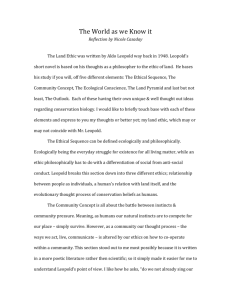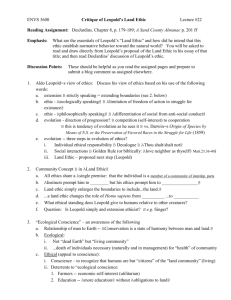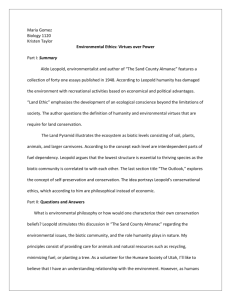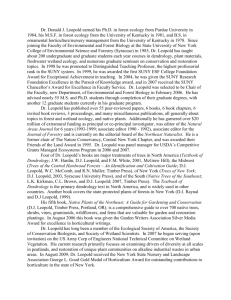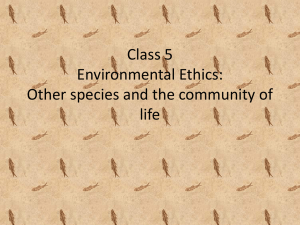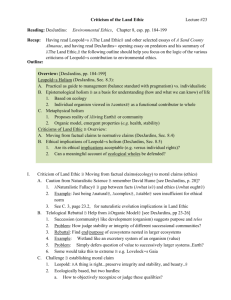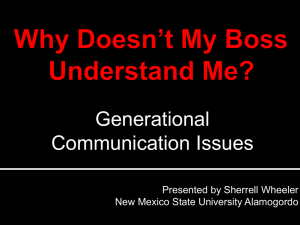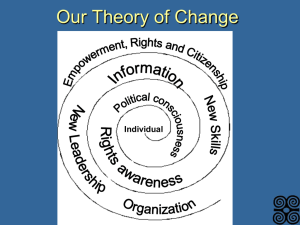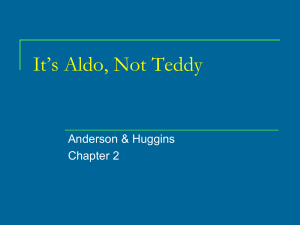The community paradigm in ecology
advertisement
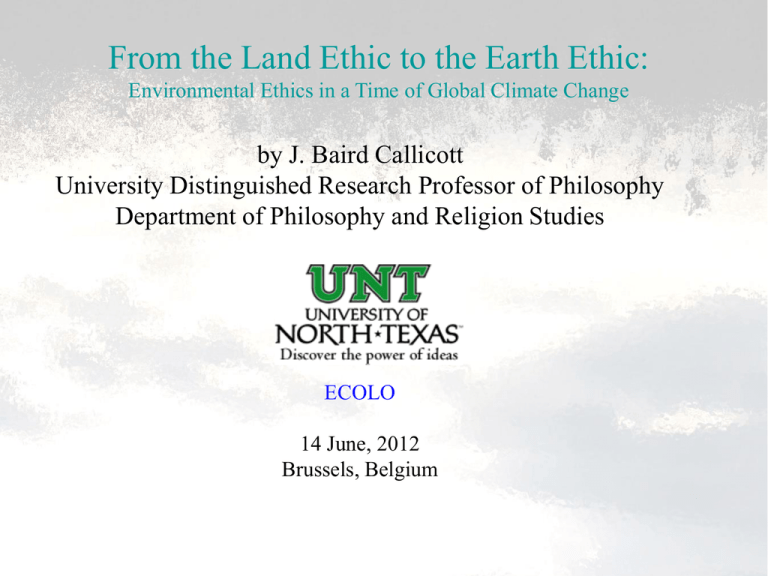
From the Land Ethic to the Earth Ethic: Environmental Ethics in a Time of Global Climate Change by J. Baird Callicott University Distinguished Research Professor of Philosophy Department of Philosophy and Religion Studies ECOLO 14 June, 2012 Brussels, Belgium environmental ethics, as sub-discipline of philosophy, emerged in 1970s major precursors: Henry David Thoreau, John Muir, Aldo Leopold 1817-1862 1838-1914 1887-1948 HDT: Nature has “higher uses”—aesthetic, spiritual, as well as material —anthropocentric (human-centered) JM: Snakes, bears, alligators have “rights” & intrinsic value —non-anthropocentric / individualistic AL: “A thing is right when it tends to preserve the integrity, stability, and beauty of the biotic community. It is wrong when it tends otherwise.” —non-anthropocentric / holistic Aldo Leopold Hailed as a ‘prophet’ anticipating the 1960s environmental crisis His book, A Sand County Almanac called ‘the bible’ of the environmental movement Its “The Land Ethic” the first extensive, systematic development of an environmental ethic The seminal text for academic environmental ethics The best known and environmental-ethic-of-choice among environmentalists and conservation biologists Aldo Leopold’s landmark ethics essays “Some Fundamentals of Conservation in the Southwest” 1923/1979 sketch of an Earth (Gaian) ethic based on “respect” “The Conservation Ethic” 1933 sketch of a consumption ethic (boycott, buy green & clean) no identifiable theoretical foundations “The Land Ethic” 1949 Darwinian evolutionary / Eltonian ecological foundations Gist of this talk: The ecological scale of the 1949 Leopold land ethic is a poor fit for global-scale, long-term environmental concerns. The 1923 Leopold Earth ethic is a better fit. Aldo 1940s 1930s Leopold 1920s Evolutionary / ecological foundations of the Leopold Land Ethic “All ethics so far evolved rest upon a single premise: that the individual is a member of a community of interdependent parts.” Ecology “simply enlarges the boundary of the community to include soils, waters, plants, and animals, or collectively: the land.” “[A] land ethic changes the role of Homo sapiens from conqueror of the land community to plain member and citizen of it. It implies respect for fellow members and also respect for the community as such.” —Aldo Leopold, A Sand County Almanac and Sketches Here and There Evolutionary foundations of the Leopold Land Ethic borrowed from Charles Darwin’s Descent of Man “No tribe could hold together if murder, robbery, treachery &c. were common; hence such crimes, within the limits of the same tribe, are ‘branded with everlasting infamy.’” If the “tribe” cannot hold together—> members would perish / fail to reproduce. Ethics evolved by natural selection as a means to social organization: vital to the inclusive fitness of individual members. LEMMA: Ethics and society (community) are correlative COROLLARY: As society evolves, ethics evolve in parallel Evolutionary foundations of the Leopold Land Ethic borrowed from Charles Darwin’s Descent of Man Extended family (clan) — Self-sacrifice Tribe — Gift economy Ethnic nation — Property rights Nation state — Patriotism Global village — Universal human rights “As man advances in civilization, and small tribes are united into larger communities, the simplest reason would tell each individual that he ought to extend his social instincts and sympathies to all the members of the same nation, though personally unknown to him. This point being once reached, there is only an artificial barrier to prevent his sympathies extending to the men of all nations and races” Ecological foundations of the Leopold Land Ethic borrowed from Charles Elton’s Animal Ecology (1927) The community paradigm in ecology: The biota is organized like human societies. Each plant and animal occupies a niche, a “role” or “profession” in the “economy of nature.” Thus: Extended family Nation state Global village Ethnic nation Biotic community “A thing is right when it tends to preserve the integrity, stability, and beauty of the biotic community. It is wrong when it tends otherwise.” Problems with the Leopold Land Ethic Developments in the science of ecology tend to undermine the LLE Biotic communities fuzzy entities: • spatial boundaries are vague and porous • samples of the same type of community are not very similar Biotic communities are dynamic at multiple temporal scales: • temporal boundaries between successional stages are vague • successional change is non-directional (not terminating in a stable, self-replicating climax stage) • natural disturbance—fire, flood, drought, wind—is frequent, and rhythmic. Thus there is little “integrity” or “stability” associated with biotic communities to be preserved The Leopold Land Ethic can be “dynamized” Biotic communities in contemporary ecology no more fuzzy than paradigmatic human communities, such as Brussels. If such human communities are robust enough to generate duties and obligations, so are biotic communities. Leopold recognized that nature is dynamic, but primarily only at the evolutionary temporal scale (in “TLE” of ASCA). We can add non-directional successional change and disturbance regimes to evolutionary change. And replace the norms of integrity and stability with norms of natural ecological dynamics —and revise the LLE’s “golden rule”: A thing is right when it tends to disturb the biotic community only at normal temporal and spatial scales. It is wrong when it tends otherwise. Dynamized Leopold Land Ethic still useful but limited Useful in re: ethically evaluating community- up to landscape-scaled and rapid and reversible human disturbances • point-source pollution • agricultural & forestry practices; recreational activities • local development (residential, commercial, industrial) Limited in re: larger, global-scaled, long-term, possibly irreversible human disturbances • climate change • mass extinction • stratospheric ozone hole First wave of “environmental crisis” from 1960s focused on former Second wave of “environmental crisis” from 1980s focused on latter 1923 Leopold Earth Ethic a better fit for contemporary global-scale, long-term environmental concerns “[It] is at least not impossible to regard the earth’s parts—soil, mountains, rivers, atmosphere, etc.—as organs or parts of organs, of a coordinated whole, each part with a definite function. And, if we could see this whole, as a whole, through a great period of time, we might perceive not only organs with coordinated functions, but possibly also that process of consumption and replacement which in biology we call the metabolism or growth. In such a case we would have all the visible attributes of a living thing, which we do not now recognize to be such because it is too big and its processes too slow. And there would also follow that invisible attribute—a soul or consciousness—which … many philosophers of all ages ascribe to all living things and aggregations thereof, including the‘dead’ earth.” 1923 Leopold Earth Ethic a better fit for contemporary global-scale, long-term environmental concerns “There is not much discrepancy, except in language, between this conception of a living earth, and the conception of a dead earth, with enormously slow, intricate, and interrelated functions among its parts, as given us by physics, chemistry, and geology. The essential thing, for present purposes, is that both admit the interdependent functions of the elements. . . . Possibly, in our intuitive perceptions, which may truer than our science and less impeded by words than our philosophies, we realize the indivisibility of the earth—its soil, mountains, rivers, forests, climate, plants, animals, and respect it collectively, not only as a useful servant but a living being, vastly less alive than ourselves in degree, but vastly greater than ourselves in time and space—a being that was old when the morning stars sang together, and, when the last of us has been gathered unto his fathers, will still be young.” Three ethical foundations of the Leopold Earth Ethic 1. A kind of individual and collective virtue ethics: “Ezekiel seems to scorn waste, pollution, and unnecessary damage as something unworthy, something damaging not only to the reputation of the waster, but to the self-respect of the craft and the society of which he is a member.”—mentioned in passing 2. Long anthropocentrism—responsibility to future generations: “the privilege of possessing the earth entails the responsibility of passing it on, the better for our use, not only to immediate posterity, but to the Unknown Future . . .”—mentioned in passing 3. Kantian non-anthropocentrism—respect for earth’s intrinsic value: “It is possible that Ezekiel respected the soil, not only as a craftsman respects his material, but as a moral being respects a living thing.”—developed over next 6 paragraphs (2 just quoted) Scientific foundations of the Leopold Earth Ethic Biogeochemistry, first articulated by Vladimir Vernadsky in the 1920s, developed by G. E. Hutchinson in the 1950s, and James Lovelock and Lynn Margulis in the last quarter of the 20th Century as the “Gaia Hypothesis”—not small-scale (community- ecosystemlevel) ecology and evolutionary (species-focused) biology (Interesting coincidence: Vernadsky coined the name “biosphere” in a 1926 book by that title only a few years after Leopold wrote “Some Fundamentals.” La Biosphere appeared in France in 1929, but was not translated into English (from the Russian original) until 1998! Leopold’s paper was not published until 1979— so there no question of influence running in either direction). So, once more Leopold turns out to be prophetic. He anticipates the Gaia Hypothesis by more than half a century. Lynn Margulis 1938- The Gaians Vladimir Vernadsky 1863-1945 James Lovelock 1919- G. E. Hutchinson 1903-1991 The Ages of Gaia (1988) Gaia (1979) The Biosphere (1926) LEE avoids the temporal- and spatial-scale problems bedeviling the LLE Biotic communities and ecosystems are difficult to isolate as robust entities—some suspect that they are mere theoretical artifacts. Communities “represent merely abstract extrapolations of the ecologist’s mind. . . . [A]n association is not an organism [as F. E. Clements had alleged], scarcely even a vegetational unit, but merely a coincidence”—H. A. Gleason (1926) “[T]he [eco]systems we isolate mentally . . . overlap, interlock, and interact with one another. The isolation is partly artificial, but is the only possible way . . . we can proceed”—A. G. Tansley (1935) The Earth, by contrast, is undoubtedly a real entity; it has clear boundaries. The Earth There is no doubt that it is a real being. Is it alive? Has it a soul or consciousness? Old balance-of-nature paradigm in ecology Ecosystems considered to be closed (except for energy and water inputs) be self-regulating (follows from closed) tend toward a single stable point of equilibrium (climax) have determinate and invariant successional pathways have disturbances as exceptional events have humans excluded from normal ecological factors —S.T. A. Pickett and R. S. Ostfeld, “The Shifting Paradigm in Ecology” New flux-of-nature paradigm in ecology Ecosystems now considered to: be open to nutrients, pollution, motile organisms have external as well as internal regulatory factors have multiple domains of ecological attraction exhibit directionless and endless successional change have disturbances incorporated—”disturbance regimes” have human influences incorporated (everywhere for millennia) have fuzzy spatial and temporal boundaries have boundaries determined by the scientific questions posed —S.T. A. Pickett and R. S. Ostfeld, “The Shifting Paradigm in Ecology” Biosphere has many characteristics of old ecosystem paradigm Closed—open only to sunlight, other radiation, and incidental cosmic material Self-regulating—the core concept of the Gaia Hypothesis Single points of equilibria for many biogeochemical cycles, e. g.: atmospheric oxygen (O2) = ~21% atmospheric nitrogen (N2) = ~78% atmospheric carbon dioxide (CO) = ~ 350 ppmv (1990) global average temperature = ~15°C —Stephen Schneider and Penelope Boston, eds, Scientists on Gaia Until recently, free of significant human influence at biospheric scale Thus the Earth as a well-defined, self-regulating entity is a robust object that we can respect as such; and its stable points of equilibria can serve as norms in relation to which we can morally evaluate those of our actions affecting these equilibria A Non-Anthropocentric Earth Ethic The LEE provides an ontologically robust object of respect: the Earth The LEE provides clear norms against which to measure and ethically assess human changes: equilibria, which also fluctuate naturally, but at rates so slow in comparison with humanlyrelevant temporal scales that they may be regarded as stable. Examples are Chemical composition of the atmosphere and oceans Global climate Global biodiversity The LEE is better scaled spatially and temporally for morally engaging post-1980s environmental concerns that are spatially global and temporally centennial and millennial in scale. Major Issue Remaining to be Determined: The Parameters of Anthropocentric Earth Ethics The foregoing considerations are essentially non-anthropocentric. What about anthropocentric earth-ethical concerns? For the present and the immediate future, we need to consider issues of “climate justice” as a key part of global citizenship. The adverse effects of global climate change will be neither evenly nor fairly distributed. Sea level rise, warming, desertification, catastrophic weather events, ecological dislocation—will hit some harder than others. Those hit hardest are often those least responsible for global climate change. Those responsible owe some form of compensation to those affected. Major Issue Remaining to be Determined: The Parameters of Anthropocentric Earth Ethics Future generations will be more severely affected than the present. So we need to consider issues of intergenerational justice. Leopold expresses concern not only for “immediate posterity” but for the “Unknown Future.” How far into the Unknown Future can we be concerned for others? I am concerned for my grandson’s future and for his grandson’s. Beyond that, personal engagement wanes. The Iroquois famously suggest that we extend our concern out for 7 generations = only 175 years + 75 year life span of 7th generation = 250 years (@ 25 yrs per generation). Major Issue Remaining to be Determined: The Parameters of Anthropocentric Earth Ethics Ecologically-scaled anthropogenic insults—oil spills, deforestation— come and go in decades. Serious deleterious effects of global climate change will not be felt for fifty years out: mid-21st Century—when many of us will be dead. And they may endure for thousands of years—far beyond 7 generations. Mitigating measures we take now may require centuries or millennia to take effect and return the climate to current equilibria. (And those measures may be swamped by natural, large-scale equilbrial fluctuations.) Outer limit would be the normal life-span of Homo sapiens as a species = ~1 million yrs. Can we have meaningful duties to people thousands and tens of thousands of years into the future? Major Issue Remaining to be Determined: The Parameters of Anthropocentric Earth Ethics One possible solution is to scale-up the effective moral agent. Leopold provides a clue: “the self-respect of the craft and the society” of which we are members. Who is responsible? Who can do something about global climate change? YOU and ME personally, individually? What can YOU and I do: drive a hybrid car, eat less meat, install compact florescent bulbs, recycle, plant trees, etc., etc., etc. All good things to do, but totally futile as an effective response to global climate change—if understood as aggregated together—because of the “free-rider problem” and “tragedy of the commons”. A Scaled-Up Anthropocentric Earth Ethic Responsibility for global climate change cannot be assigned to individual agents—individual persons. It is the effect of our collective behavior and thus requires a collective response—changes in policy and law, not changes in individual behavior. More deeply we need to make a metaphysical change in how we conceive of our relationship to Earth. Individual action in the Age of the Internet can lead to social selforganization, a movement to change laws, regulations, tax codes —to provide incentives: in the form of rewards for good environmental behavior and penalties for bad. Changes in law and regulation in turn, reinforce ethical commitment. Social self-organization and consciousness raising can lead to the removal of the impediments and provision of the incentives to move the economy toward carbon neutrality by eliminating crony capitalism and subsidies for obsolete fossil-fuel industries. Earth Ethic Moral Patient (Object of Concern)? Earth itself not at risk: Has survived multiple past catastrophes in 3.5 billion yr biography—oxygen crisis, five mass extinction events, large meteor impact—only to speciate ever more biodiversity Homo sapiens probably not at risk: Will survive both nuclear holocaust and radical climate change. Global human civilization at grave risk: Presently over-connected, extremely complicated, very fragile. We see increasing instances of “failed states”—Somalia, Yemen, Afghanistan, Syria . . . The recent financial crisis indicates how over-connected, complex, and fragile is the global economy and governance. The temporal scale of the human collective is measured in centuries, not decades: In the LE Leopold suggests that Western civilization goes back three thousand years to the time of Odysseus. Thus, on this scale, the present civilization can envision itself continuing for perhaps another three thousand years—with duties now to itself then. That coincides with the temporal scales of our current global environmental concerns. The ethical response to global climate change must be scaled to the scale of the problem: The effective agent is not the individual, but the global village; the effective temporal scale is not comprehensible multiples of an individual life-span, but of an enduring human civilization
